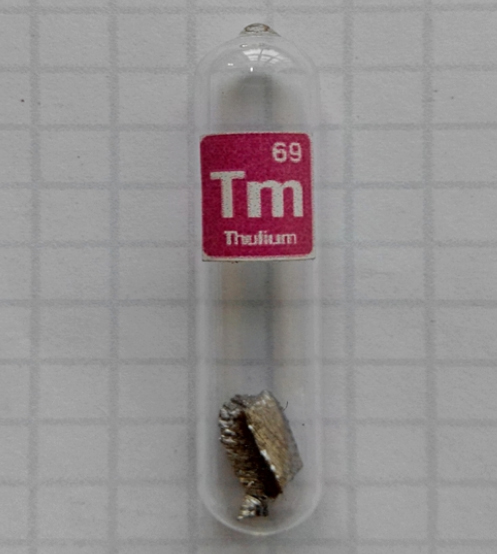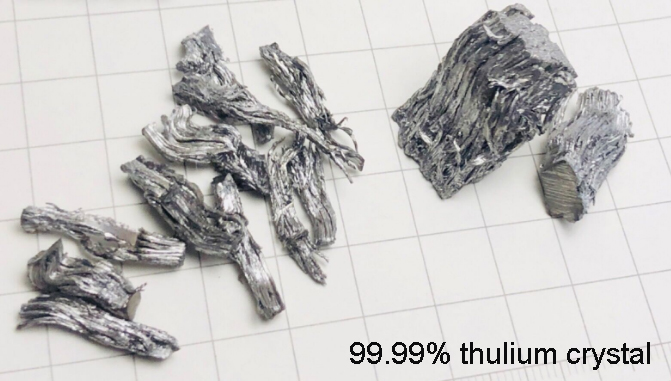Thulium metal
Thulium: atomic number 69, atomic weight 168.93421. The element
name comes from the country name of the discoverer. In 1879, Swedish
scientist Clive separated two new elements, thulium and holmium from
erbium soil. The content of thulium in the earth's crust is two hundred
thousandths, which is the element with the least content of rare earth
elements. It is mainly found in xylonite and black rare gold ore. The
natural stable isotope is only thulium 169.
Thulium is a silver-white metal, malleable, and can be cut with a soft
knife; the melting point is 1545°C, the boiling point is 1947°C, and the
density is 9.3208. Thulium is relatively stable in the air; thulium
oxide is a pale green crystal. Silver-white metal, soft in nature, has a
high vapor pressure at the melting point. Salt (divalent salt) oxides
are light green.
There are not many uses for thulium, mainly as an additive for metal
halide lamps, and thulium is mainly used to emit a wide range of green
emission lines.
In the nuclear reaction, 169Tm is irradiated to generate 170Tm with a
half-life of 129 days. This isotope gram emits strong X-rays. It is used
to make portable X-ray machines that do not require power supply, and it
is also used as a phosphor activator. Radioactive thulium is used as the
radiation source on the portable X-ray machine, which eliminates the
need for electrical equipment..
.
.
.


Thulium: atomic number 69, atomic weight 168.93421. The element
name comes from the country name of the discoverer. In 1879, Swedish
scientist Clive separated two new elements, thulium and holmium from
erbium soil. The content of thulium in the earth's crust is two hundred
thousandths, which is the element with the least content of rare earth
elements. It is mainly found in xylonite and black rare gold ore. The
natural stable isotope is only thulium 169.
Thulium is a silver-white metal, malleable, and can be cut with a soft
knife; the melting point is 1545°C, the boiling point is 1947°C, and the
density is 9.3208. Thulium is relatively stable in the air; thulium
oxide is a pale green crystal. Silver-white metal, soft in nature, has a
high vapor pressure at the melting point. Salt (divalent salt) oxides
are light green.
There are not many uses for thulium, mainly as an additive for metal
halide lamps, and thulium is mainly used to emit a wide range of green
emission lines.
In the nuclear reaction, 169Tm is irradiated to generate 170Tm with a
half-life of 129 days. This isotope gram emits strong X-rays. It is used
to make portable X-ray machines that do not require power supply, and it
is also used as a phosphor activator. Radioactive thulium is used as the
radiation source on the portable X-ray machine, which eliminates the
need for electrical equipment..
.
.
.

|

|
